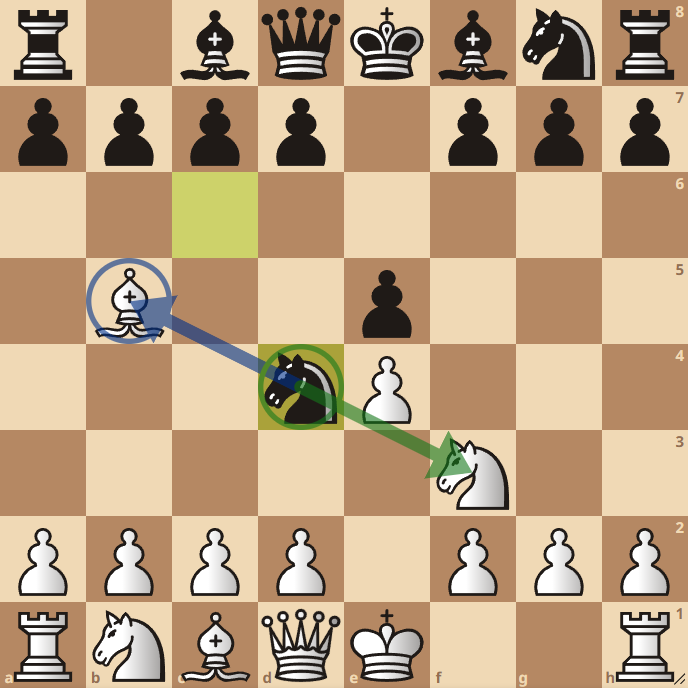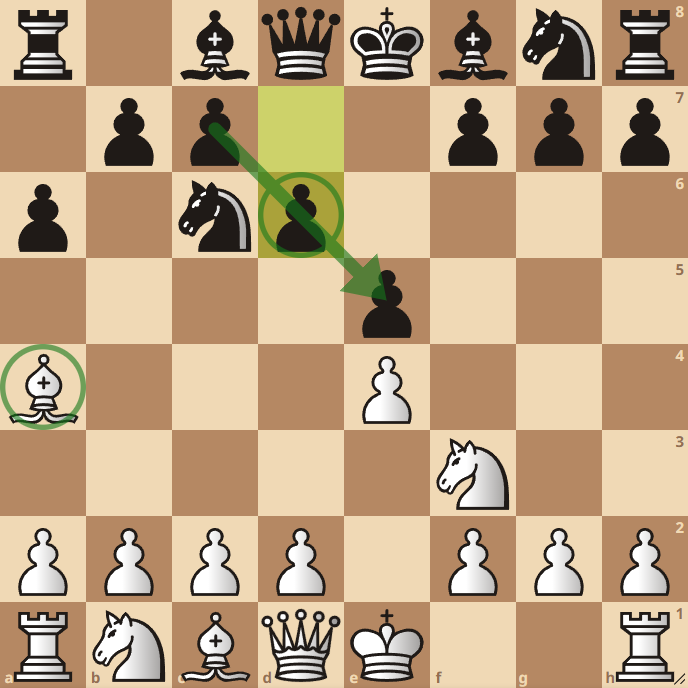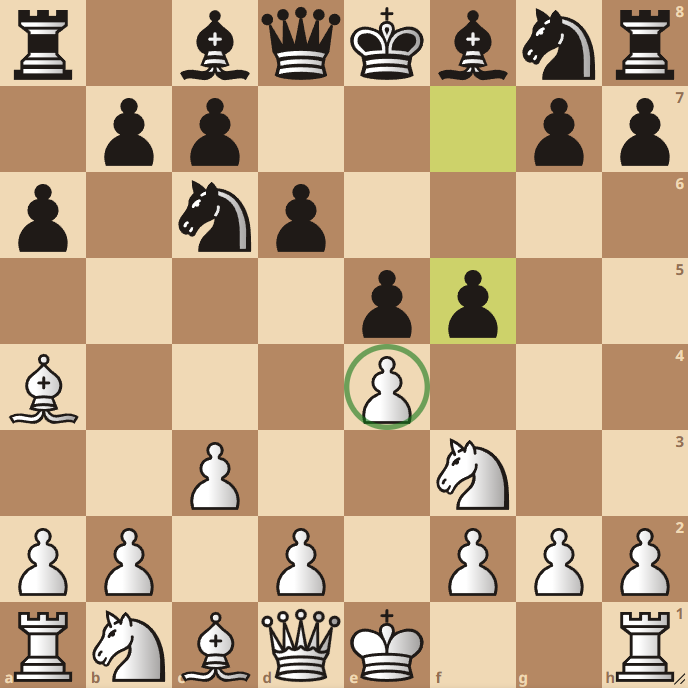Join our exclusive newsletter for opening guides, tips, and inspiration. Our community of 5,131+ chess enthusiasts is waiting for you.
Don't wait – enter your email below and join now!
Cracking the Code: Unveiling the Ruy Lopez Chess Opening
Ready to up your chess game? Look no further than the legendary Ruy Lopez chess opening! From its rich history to its strategic variations, this opening is a must-know for serious players. Discover the short answer to why it’s a game-changer and get ready to elevate your chess skills to new heights. Let’s dive in!
The Ruy Lopez Chess Opening:
The Ruy Lopez starts after the moves: 1.e4 e5 2.Nf3 Nc6 3.Bb5
The Ruy Lopez is known for its adherence to classical opening principles. White and Black both grab central space on move one and develop a knight on move two. With 3. Bb5, white accomplishes three things:
– White develops another piece
– White gets closer to castling kingside
– White puts some positional pressure on black.
At the right moment, white may be threatening to exchange this bishop for the c6 knight to remove the defender of black’s e5 pawn, when white could win a pawn with Nxe5.
The Ruy Lopez (also called the Spanish Game or the Spanish torture) is one of the oldest chess openings. It was named after Ruy López de Segura, a Spanish priest and chess player who lived in the 16th century. The first mention of the opening was found in Libro del Ajedrez (the book of chess) from 1561, and it has been analyzed and improved upon ever since then.
Similar posts you may enjoy:
- Ultimate Guide: Learn the Chess Pieces Names and Moves
- How to Win Against the Philidor Defense
- Chess Openings – How to Destroy Your Opponent in the Open Game
- The Italian Game – The Best Chess Opening For White
- The French Defense – Learn a Top 3 Chess Opening For Black
- How to Learn the Giuoco Piano (C50) Chess Opening
- How You Can Study Chess Openings – Get Instant Results!
Watch the Ruy Lopez Opening Instructional Video:
Opening Insights: Decoding the Ruy Lopez Variations
Hello everyone, this is Mr Chess at Chess Lovers Only – where I provide some chess opening videos and also play live chess games and talk about my thoughts as I play them I’m trying to give lots of nice chess instructions to help you improve your game.
So today I’m going to talk about the Ruy Lopez – an overview of the Ruy Lopez and go through some of the… mainly side variations first… side variations and I’ll walk through into the main variations. In later videos, I’m going to talk more about the main variations and talk about them in more detail.
So let’s talk about the Ruy Lopez. The Ruy Lopez starts with e4 e5, knight f3 knight c6, and then bishop to b5 bishop.
Bishop to b5 indirectly attacks the e5 pawn because if white takes and black takes with whatever pawn then white can take the e5 pawn and that’s the main point.
So it’s not the Italian game where the bishop stands on c4 and attacks the f7 pawn. Instead, it’s indirectly attacking the e5 pawn because if white takes the knight… if white takes the knight and Black takes back then White can capture the e5 pawn.
Ruy Lopez Variations:
Now, there are a few different variations that stem from this starting position and the main one, which is a6, and that’s called Morphy’s Defense which puts the question to the bishop.
But there are also lots of other ones so the first one we’re going to have a look at is f5.

Black Defences Other Than 3… a6 (Morphy’s Defence):
Schleimann Defence – 3…f5
F5 is called the Schleimann Defense. Also, the Jaenisch Gambit – it kind of looks like a reverse king’s gambit which attacks this pawn and also puts pressure on to white center.

Steinitz Defence – 3…d6
Now there’s also d6 which is called Steinitz Defence and this is kind of like a Philidor Defence, except there’s a knight and a bishop here.
There’s also another opening like another variation called the Neo-Steinitz Defence, which looks similar to the 3. d6.

Cordel Defence – 3…Bc5
There’s also bishop to c5. Bishop to c5 puts pressure on the f2 pawn. Kind of similar to the Italian Game or those kinds of positions as well. Bishop to c5 is the Cordel Defence.

Bird’s Defence – 3…Nd4
There is also Bird’s Defence with Knight to d4. Now Knight to d4 attacks this knight, but also attacks the bishop. Sometimes you really need to make sure that you know about the backward knight jumps. Backward Knight jumps – like if I see this in my game I probably only see the knight attacking this knight and I’ll be like, “Okay, fine. Let’s kick it out.” But then it takes your bishop and you’re like, “Oh my god, I made a mistake.”
You better be careful. You better be careful. Watch out for backward knight jumps. Knight to d4 – this is called the bird’s defence, attacking the bishop mainly because that’s the main weapon in the Ruy Lopez.

Berlin Defence – 3…Nf6
One more thing is it’s a pretty popular opening for top grandmasters if they want to draw or pretty much in general.
That move is knight to f6. Now knight to f6 is called the Berlin Defense and this walks straight into the Berlin End Game where pretty much top grandmasters play in tournaments in order to get like a draw. That happened maybe two-three years ago – the Berlin Defence was super popular.
The Berlin Endgame was super popular to get draws and now lots of top GMs have come up with Anti-Berlins where they defend this pawn and they defend this pawn and they try to get out of this kind of drawish kind of game.

So there are a few… a lot of different moves that end up after this position – Morphy’s Defense which is like 90 percent of games. There’s Schliemann Defense with f5.
There’s also the Steinitz Defense – d6 which defends this pawn, and there’s the Cordal Variation with bishop to c5 and attacks the f2 pawn. There’s the bird defense which attacks this bishop, mainly. And the Berlin Defense with knight to f6.
Morphy’s Defence – 3…a6
Now the most popular, as I said before, was Morphy’s Defense. Pretty much 90 per cent of games end up with Morphy’s Defense – 3…a6.

Morphy Defence, Exchange Variation – 4. Bxc6
There are two main things that the bishop can do. The first one is the bishop can take the knight and then normally they play d takes c6 and this is called the Exchange Variation of the Ruy Lopez. This is probably the easiest variation to learn if you are white if you’re a Ruy Lopez player.
Now, after a6, Morphy’s Defense, the bishop can also go back to a4 and that keeps the kind of pin. If the pawn moves, it’s a pin, right? It still keeps pressure on the knight which threatens to capture this pawn. From this case, there are three main variations after this.

Morphy Defence, Taimanov Variation – 4. Ba4 b5 5. Bb3 Na5
The first one is straight away b5 getting rid of the pin. This is called Taimanov variation (or Norwegian Defence, or Wing Variation) and after that it’s bishop to b3 knight to a5, which attacks this bishop, wanting to capture that. Because like I said before the main weapon in the Italian game and also Ruy Lopez is the light square bishop which puts pressure on black’s centre – indirectly or either on f7.
Now after this white just castles. There’s no real place to put the bishop anyway. So white castles, d6, d4 striking in the centre, knight takes b3, a takes b3, and f6 which reinforces the defence of this pawn. But f6 – never play f6 says Ben Finegold.
Now if we go back to bishop to a4 which is here – there are two other variations I said, yes?

Morphy Defence, Neo-Steinitz Variation – 4. Ba4 d6
The first one is d6 which is called the Neo-Steinitz Variation and this is very similar to back then on move three where black played d6. But instead, there’s some insertion on the move, there’s a6 and there’s also bishop to a4. So that’s a little bit different, right?
Neo-Steinitz Variation is kind of a little bit better than the Steinitz Variation but it’s not as popular as the main lines, which we’ll walk through a bit later. So Neo-Steinitz is kind of similar to the Philidor Defense structure as you can see. I have put the arrows there. Let’s go back.
Neo-Steinitz – after that there are four different variations that white can go into.

Noah’s Ark Trap:
The first one is d4 – striking in the centre straight away. After that b5, bishop to b3, knight takes d4, knight takes d4, e takes d4, and here there is a trap. There is a trap against White. White might lose its light square bishop.
How that can happen is you can think, “Wow this is a free pawn. I want to take this pawn. I can take this pawn.”
You take the pawn with your queen but that is a mistake because black has pawn to c5 attacking the queen. The queen can move somewhere, like if the queen moves back… that’s even worse right. That’s a pretty bad move, bang, fork. Plus the bishop is lost. You’d have to go take, take, take. Things like this. But you’ve lost the piece pretty much. So let’s go back. That was the Noah’s Ark Trap. Noah’s Ark Trap.

Sharp Game – 5. Bxc6+ bxc6 6. d4
Now let’s go back to the Neo-Steinitz, which is before d4. In the Neo-Steinitz, one of the moves is d4 but there is also bishop takes c6 check. Now black has to take the pawn – b takes c6, d4 striking in the centre again. That’s a pretty standard move in the Ruy Lopez and the Italian Game. Those kinds of positions.
There can be e takes d4 or there can be f6 which reinforces the structure… reinforces black’s center. But “never play f6,” says Ben Finegold.
All right, let’s go back to the Neo-Steinitz. Neo-Steinitz variation – so after Morphy’s Defense, d6, there is also one or two more lines.

Siesta Variation – 5. c3 f5
The next line is c3 which is building up for this move to put pressure on black’s centre. The only problem is white’s knight can’t develop to its natural square. So we have c3. There’s three different kinds of lines that black can play.
The first one is f5 striking in the centre straight away right. Never play f6 but f5? Who knows. This is called the Siesta Variation, putting pressure on white’s center.

Manoeuvering Game – 5. c3 Bd7 6. d4
There is also bishop to d7. Bishop to d7 which eliminates the pin. After that white has the simple d4, which is what white wanted to do, right? Put pressure on black’s center.

Black can respond in three different ways:
The first way is knight f6, castles, bishop to e7 – wanted to castle, rook e1 – putting pressure on the e-file, and castles. This is okay. It’s like forty per cent win rate. Forty or above win rate for white.
We go back to d4. Black can also respond with knight to ge7 and that’s a pretty peculiar way to develop right. How is the black bishop going to get out?
Now after that castle and we have knight to g6. So you can see this is the way the black bishop is going to get out. There’s a maneuver with the knight to come here because the knight wants to come to this square. It can be traded off but it is protected by the pawn. Then the black bishop will come out and black will castle this way.
So that’s another way that black can develop.
Now let’s go back to d4 striking in the center. Another way that black can respond is g6 and black can develop the dark squared bishop to this square g7 and have a have some fun on the long diagonal, right? If there’s an exchange here – it’s still biting on granite, right? With this pawn… this pawn formation, but the long diagonal, that’s having some fun.
After that castle, bishop to g7, and black would be fine.
Okay, now let’s go back to Neo-Steinitz, which is in this position d6.
White Castles – 5. 0-0
Another way is for white just to castle. Now white castles, bishop to g4 pinning the knight, and White can’t break the pin with the bishop, right? Because the bishop’s over here. But white can actually take and destroy Black’s structure. But the main point is the center, yeah? Take control of the center.

H3, h5. Now here is a good trick right? If we take, take, knight has to move, the queen can come into h4 and checkmate the white king on either h2 or h1. Because black hasn’t castled yet and it has a rook on that side, right?
So if we go back you don’t really want to take. There are no moves in the master database of taking
because they don’t want to get checkmated, right?
So white instead plays d4 striking in the centre. Now we have b5, which gets out of the pin. Bishop to b3, knight takes d4, and here we have a double attack on the knight. The knight attacks the bishop as well so white really has to take this time. H takes g4.
Oh, but isn’t White going to get checkmated. Let’s see what happens. No, because the knight can… there’s no pin anymore… the knight can come over here and block black’s queen from coming into h4 because it is protected by the bishop. Now we have knight to h6 because white was threatened in a fork on the f7 square.
So there’s that kind of variation as well. It’s a pretty interesting variation, right? With this Neo-Steinitz.
Morphy Defence, Mackenzie Variation – 4. Ba4 Nf6 5. d4
Okay, let’s go back and after bishop to a4, which happens after Morphy’s defence, right? Bishop to a4. We also have knight to f6. Knight to f6. Let’s get it on the board.
Knight to f6. Black is attacking this pawn. What does white do? White has a lot of different moves.
White has one, two, three, four, five different moves.

The first one is d4 striking in the center – that’s called the center attack or the center gambit. It’s pretty interesting. We have e takes d4, e5 which attacks the knight, knight to e4 – centralizing the knight, white castles, bishop to e7 – because black also wants to castle, and knight takes d4.
Now we also have a standoff between the knights. If knight takes and the pawn takes, we have a queen trade. The bishop’s here protecting so it’s fine. That’s one variation.
Morphy Defence, Anderssen Variation – 4. Ba4 Nf6 5. d3
Let’s go back to knight f6, knight f6. now. We had d4, right? White can also play d3, which just reinforces this pawn.

Here we have two different moves that black can do. One is d6 which is similar to the Neo-Steinitz Variation. Remember this kind of pawn formation.
Or black can respond with b5 which gets out of the pin. After that, we have bishop to b3, and black can respond with bishop to e7 to castle, or bishop to c5 to put pressure on the f2 square. Just some pressure nothing else.
Morphy Defense, Tarrasch Variation – 4. Ba4 Nf6 5. Nc3
Okay, let’s go back to knight f7. So we had d4, we had d3, what else can white do? Well, White can defend the pawn with knight to c3. Defending the pawn this way, right?

After this, we have b5 – getting out of the pin, bishop to b3, bishop to e7, and here black wants to castle. White has two different kinds of lines that they can take.
The first one is d3 – which reinforces the center pawn, d6 – black reinforces its own center, and white goes in with knight to d5 – trying to take the initiative. This is kind of unclear with the master’s database. A little bit unclear. This is called the Tarrasch Variation.
Or if we go back to bishop to e7 White can also just castle. We don’t need to reinforce this pawn, right? It’s only attacked once.
So white castles, we have d6 – where black reinforces his own center, and the knight jumps in, and black captures the e4 pawn. Why did white give it up? Let’s check.
After that we have d4 – which strikes in the center. Yeah, it’s all about the center. Strikes in the center and white wants to play rook to e1 to put some pressure down the e file. So that’s another variation. So if we go back that would be 5. knight c3 – defending the pawn with the knight.
Morphy Defence, Wormald Attack – 4. Ba4 Nf6 5. Qe2
Okay, so we had d4, d3, Knight to c3. What else can white do to defend this pawn? Well, White can actually play queen to e2 to defend this pawn. It’s quite interesting. If the center opens up maybe the white queen is a bit okay there, right?

So after that we have b5 – getting out of the pin, we have bishop to b3, and here black can respond in two different ways.
There’s bishop to c5 – putting pressure on the f2 square, f2 pawn, or we just have the simple bishop to e7. Bishop to e7 so that black can castle. Castle, d6 – reinforcing the center, c3 – because white wants to strike in the center, yeah? With the queen on the e file White wants to strike, wants to get some blood. C3 and black castles, get it out of the center. So here’s that variation as well.
Critical Move: 4. Ba4 Nf6 5. 0-0
Okay, let’s go all the way back to 4. knight f6 where black puts pressure on the white pawn. Okay so we had d4, we had d3, knight c3. We also had queen e2. What else can white do to defend this pawn?
Well, actually White doesn’t need to defend it. White doesn’t need to defend it.
The most popular move in this position is just castle, and that’s with 66,000 master-level games.

Okay, so now, this is where the main variations of the Ruy Lopez start.
There are three main variations:
Open Ruy Lopez: 4. Ba4 Nf6 5. 0-0 Nxe4
The first one is okay, black says fine if you’re gonna give up your pawn, give it to me. I’m gonna take it. It’s mine. Knight takes e4.

Now, this is called the Open variation or the Open Spanish, because it’s gonna… Well, if white takes then White can take the pawn, right? It’s gonna open up, so it’s gonna be open. There’s gonna be lots of lines – that’s why it’s called the open variation. I’ll make a video with more detailed information on this line afterwards.
Closed Ruy Lopez: 4. Ba4 Nf6 5. 0-0 Be7
Also, black can just go bishop to e7. Still looking at this pawn, just wanting to castle – it’s okay, it’s not that passive. Bishop to e7 is fine. This is called the Closed Variation, the Closed Spanish, because the pawn is still there. White will defend it the next turn.

Either rook to e1 or d3 defending the pawn and so it’s a more closed kind of structure, right? Where there’s more maneuvering and things like that.
Arkhangelsk (Archangel) Variation – 4.Ba4 Nf6 5. 0-0 b5
Also a new line, that’s been pretty popular since the mid-1990s, is a move that we have seen a lot of times which is b5 to get out of the pin straight away.

This one is super popular by Fabio Caruana and also Carlson. Carlson’s played this four times – three against Fabiano: 2015, 2016, 2020 – and also Nepo in 2021, which might have been their world cup match – where the game just went bishop down across, putting pressure on the pawn. So pretty similar and this is called the archangel variation.
Summary of Ruy Lopez:
Okay, so that was pretty much the quick overview of all the sidelines and moving into the main variations of the Ruy Lopez.
So let’s go back and see what the main variations are, okay?
So we have e4, e5, knight f3, knight c6 and the bishop goes to b5. This is the starting position
of the Ruy Lopez.
There are lots of sidelines which I showed you – there’s five.
The main one is a6 Morphy’s Defence. The bishop goes back, bishop to a4, and then the main line is knight to f6 – putting pressure on the pawn.
The critical move that you need to remember as white is castle. This is where all the main variations start.
The most popular is bishop to e7, which is the closed variation. After that white will just defend the pawn and there are so many games played in this variation, okay? So nice and quick.
Later videos will take you into more detail and a lot more things about the Ruy Lopez, okay? Cool.
This is Mr Chess at Chess Lovers Only. Like, subscribe, and share. You’ll learn so much more if you share, like, and subscribe. I’ll see you next time, bye.
FAQs
Is The Ruy Lopez a good opening?
Yes, the Ruy Lopez, also known as the Spanish Opening, is considered one of the oldest and most respected chess openings. It offers a solid foundation for controlling the center and has been played by numerous world champions and top-level players, making it a reliable choice for many chess players.
Do grandmasters play Ruy Lopez?
Yes, many grandmasters regularly play the Ruy Lopez as a part of their opening repertoire. It is a popular choice among top-level players due to its strategic complexity and versatility, allowing for a wide range of pawn structures and plans, which can lead to interesting and challenging games.
Is the Italian or Ruy Lopez better?
Both the Italian Game and the Ruy Lopez are well-respected chess openings and have been played by many top players. Whether one is better than the other depends on individual playing styles and preferences. The Italian Game is known for its aggressive pawn play, while the Ruy Lopez offers a more solid and strategic approach. Both openings have their strengths and weaknesses, and the best choice may vary from player to player.
What is the #1 best chess opening?
There is no definitive “best” chess opening, as it largely depends on individual playing styles and preferences. Many openings can be effective when played well, and different players may have different favorites. It’s important to study and practice various openings to find the ones that suit your style and lead to positions you are comfortable playing.
What is Magnus Carlsen’s most used opening?
Magnus Carlsen, a world-renowned chess player and former world chess champion, has a diverse opening repertoire and has played many different openings throughout his career. However, he is known to frequently use the Queen’s Gambit Declined, as well as the Berlin Defense in response to the Ruy Lopez. He has also played the Sicilian Defense and the King’s Indian Defense, among others.
What is the statistically worst chess opening?
There is no definitive “worst” chess opening as it largely depends on how it is played and the skill level of the players involved. However, some openings, such as the Grob’s Attack and the Barnes Opening, are considered less popular and less commonly played at the highest levels of chess due to their perceived weaknesses and lack of sound strategic principles. It’s important to study and understand the basic principles of chess openings to avoid falling into traps or getting into unfavorable positions.
Let’s Chat!
What’s your favourite chess opening?
What other questions do you have about the Ruy Lopez chess opening?
Leave me a comment below!
Peace!
A.J. McMahon
.
.
.
Let’s Connect!
– Instagram: Chess.Lovers.Only
– Pinterest: ChessLoversOnly
– Facebook: ChessLoversOnly
– Twitter: ChessLoversOnly
– Youtube: ChessLoversOnly


















The Ruy Lopez is one of the best chess opening you can learn as a beginner! I highly recommend it!!